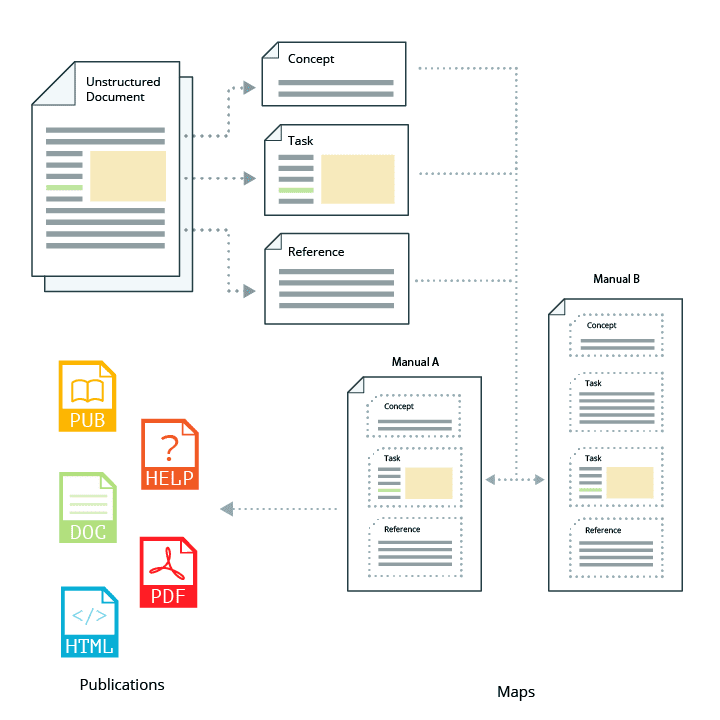DITA maps link topics without any need to copy and paste content across documents. Think of DITA maps like a table of contents, and how you arrange topics in those maps creates the structure of the document you’re building. Once you have content structured in topic types, you can assemble and reuse those topics in DITA maps for use in multiple documents.
Want to learn more about topic types? Read our What is DITA explainer.

The Power of Maps
Maps may be seen as the secret sauce that makes DITA such a powerful way of creating, organizing, and distributing documentation. The key function of maps is organizing content. Very often documentation related to a subject like a product or a policy takes different forms that often utilize the same information in somewhat different ways. An Installation Manual and a Troubleshooting App may both have overlays of the same content in different contexts. Multiple maps can link to and utilize the same piece of content from the database.
This avoids duplication of effort and concerns about version control for content found in multiple documents. It also enables global updates of content across multiple uses in different docs. When you update a content “chunk”, it is updated in any map where it is used.
To learn more about reusing the same piece of content, here's our How to Reuse Structured Content With DITA post.
Maps Are Not a Formatting Tool
While maps determine the order in which the information is presented, they do not contain formatting. Formatting is applied when the map is published and that formatting is specific to the publishing media chosen. Because of this, the same map can be published to a wide variety of distribution media from PDF to mobile, without changing the map.
This helps with two important issues:
- Authors and reviewers do not need to be involved with formatting, which saves enormous amounts of time.
- Managing changes in information is extremely efficient. Change the content chunks requiring the changes and republish any maps containing that content. All instances are updated identically, eliminating errors and omissions.
Wrap Your Head Around It and the Lightbulb Will Turn On
Understanding maps is the key to understanding the huge difference between unstructured environments like desktop software and centralized component content management systems. Authoring in topics and other DITA elements and then organizing their structure with maps means your information is usable as data rather than discrete files.This, in turn, opens up an entire set of new ways to manage, reuse, and distribute your information efficiently. It may take a little time get used to the basic concepts of DITA authoring and publishing but when you do, you’ll find yourself in a much more powerful place as an information creator and manager.
* For the purposes of this basic explanation, chunks are content with specific functions in a DITA CCMS. The most common chunk is a Topic which can be a Concept (description), Task (ordered list), or a Reference (specification or other fixed content). Authors create each of these functional pieces and assemble them (with a map) to create a document. Learn more in our ‘What Is Dita?’ article.




